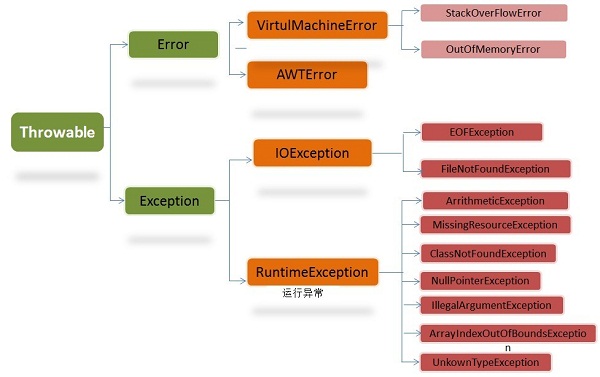Java checked unchecked异常 详解Java中的checked异常和unchecked异常区别
在地图上飞行 人气:0(一)Java的异常层次结构
要想明白Java中checked Exception和unchecked Exception的区别,我们首先来看一下Java的异常层次结构。

这是一个简化的Java异常层次结构示意图,需要注意的是所有的类都是从Throwable继承而来,下一层则分为两个结构,Error和Exception。其中Error类层次描述了Java运行时系统的内部错误和资源耗尽错误,这种错误除了简单的报告给用户,并尽力阻止程序安全终止之外,一般也米有别的解决办法了。
(二)unchecked异常和checked异常的区别
有了上面的认识之后,我们再来看什么是checked异常,什么是unchecked的异常。其实,Java语言规范对这两个定义十分简单,将派生于Error或者RuntimeException的异常称为unchecked异常,所有其他的异常成为checked异常。尽管,这个定义十分简单,但是RuntimeException却是一个非常让人容易混淆的观念,似乎我们所有的异常都是在程序运行的过程中。我《Effective Java》中关于Ru ntimeException异常的阐述也不是那么尽如人意,
Use checked exceptions for recoverable conditions and runtime exceptions for programming errors (Item 58 in 2nd edition)
不过从这句话中我们可以简单引申一下,也就是说,如果出现了RuntimeException,就一定是程序员自身的问题。比如说,数组下标越界和访问空指针异常等等,只要你稍加留心这些异常都是在编码阶段可以避免的异常。如果你还是觉得这两个概念不好区分,那么“最暴力“的方法就是将常见的RuntimeException背下来,这样就可以省去很多判断的时间。
(三)为什么要对unchecked异常和checked异常进行区分?
原因其实很简单,编译器将检查你是否为所有的已检查异常提供了异常处理机制,比如说我们使用Class.forName()来查找给定的字符串的class对象的时候,如果没有为这个方法提供异常处理,编译是无法通过的。

(四)我们应该对哪些异常进行声明?
我们前面说,RuntimeException是在programing过程中可以避免的错误,那是不是我们就不需要抛出这些异常呢?原则上来说,是这样的,但是Java规范中并没有对此进行限制,只是看上去你抛出一个数组越界的异常并没有多少实际意义,相反还会对性能造成一定的损失。那么我们应该如何来设计抛出异常呢?我们要记住以下两种情况是必声明throws异常的:
调用一个checked异常的方法,例如IOException,至于原因我们前面已经讨论过了,如果抛出所有的checked异常时无法通过编译的。程序运行过程中发现错误,利用throw语句抛出一个异常。对于unchecked异常,无非主要是两种情况要么是可以避免的(Runtime Exception),要么是不可控制的。这些也是需要声明异常的。
下面列举例子说明上面的注意事项2中提到的比较别扭的地方:
首先定义一个基本的异常类GenericException,继承于Exception。
package check_unchecked_exceptions;
public class GenericException extends Exception{
/**
*
*/
private static final long serialVersionUID = 2778045265121433720L;
public GenericException(){
}
public GenericException(String msg){
super(msg);
}
}
下面定义一个测试类VerifyException。
package check_unchecked_exceptions;
public class VerifyException {
public void first() throws GenericException {
throw new GenericException("checked exception");
}
public void second(String msg){
if(msg == null){
throw new NullPointerException("unchecked exception");
}
}
public void third() throws GenericException{
first();
}
public static void main(String[] args) {
VerifyException ve = new VerifyException();
try {
ve.first();
} catch (GenericException e) {
e.printStackTrace();
}
ve.second(null);
}
}
运行后,在eclipse的控制台上得到下面的信息:
check_unchecked_exceptions.GenericException: checked exception
at check_unchecked_exceptions.VerifyException.first(VerifyException.java:6)
at check_unchecked_exceptions.VerifyException.main(VerifyException.java:23)
Exception in thread "main" java.lang.NullPointerException: unchecked exception
at check_unchecked_exceptions.VerifyException.second(VerifyException.java:11)
at check_unchecked_exceptions.VerifyException.main(VerifyException.java:29)
上面的例子,结合checked以及unchecked的概念,可以看出Exception这个父类是checked类型,但是其子类RuntimeException (子类NullPointerException)却是unchecked的。
加载全部内容